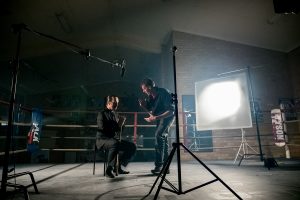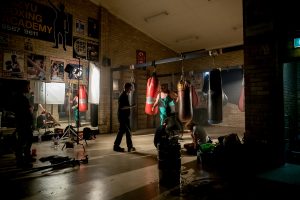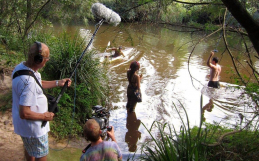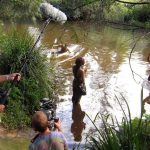DROP THE MIC began with meeting Kieran Burns on a friend’s music video shoot. He was sharply attired in black with hair slicked into fashion akin to some modern day samurai. There was also the cane… which never left his side.
I was intrigued to learn more about this character.
 After a brief, lunch-time chat, I discovered that Kieran Burns was actually a ring announcer, and affectionately known as ‘Duke’ in the wrestling world – a sport he had loved from an early age.
After a brief, lunch-time chat, I discovered that Kieran Burns was actually a ring announcer, and affectionately known as ‘Duke’ in the wrestling world – a sport he had loved from an early age.
It was also the first time I’d hear of Guillain-Barre syndrome (GBS), the rare muscle weakening disease responsible for the excruciating physical and emotional duress Duke’s body was at the mercy of.
Here was a man whose working environment was rampant with hulking gladiators that would fly through the air, only to come crashing down on the canvas they grappled on with a thunderous WHAM! And yet, the slight physique (comparatively to his colleagues) of the thirty-something Duke, would hold his own inside the ropes. At least, that’s what he would be striving for before announcing each match…
I came to learn that Duke’s greatest fear was that too soon, he would be physically incapable of doing the thing he loves most, due to his condition. It was Duke’s strength of character and sheer will to overcome his struggles that convinced me to pursue the making of a documentary.
When you encounter a story filled with as much drama and emotional gravitas as Duke’s, I have found that an inherent tone tends to define itself. The black and white, the plumes of talc wafting through the air, the ominous lighting – all elements combined that would dictate the look and feel of the film.
Now from this point on, it would have been fine to just do up a shot-list, devise a string of interview questions and away we go. But unless you are a one man crew, thorough documentation of your creative vision is an absolute must; and after having spent the time doing exactly that, I have come to believe this unseen prep absolutely affects your film’s quality a million-fold.
Here’s just a few key elements and what I learnt from the documentation phase of Drop The Mic:
- By writing a logline – from the get-go, there was no confusion for cast and crew as to what we were striving to achieve. A huge fear for me as a director is having someone say “umm… yeah. I don’t get it”, only to waste precious minutes on the day of shooting by going into some long-winded description of the story.
- By writing a detailed story outline – I was able to devise a pertinent list of interview questions; designed to extrapolate useable responses. Also, by applying ‘story structure’ to Duke’s story, the edit assembly went lightning quick because I was giving myself a rough order already, of where Duke’s responses might go.
- By designing a mood board – the cinematographer was able to access my head space and with a canvas of pre-visualizations, we were able to discuss in greater detail the lighting, composition and practicalities of achieving some potentially complex set-ups.
The above might seem basic on the surface and therefore easily discarded. Coming from a ‘run-and-gun-get-what-you-can’ filmmaker background, I have to admit, it was tempting to go this route and just pick up a camera and shoot this thing, ignoring the documentation phase altogether.
This rough-and ready style I’m talking about – it’s not that I think it’s bad or even inappropriate; in fact, I believe Drop The Mic could have been made this way and a fine result be achieved. But the documentation phase MUST be there – whether you’re going for that gritty ‘Murderball’ vibe or something with perhaps more cinematic grace a la ‘The Imposter’, regardless of your stylistic approach, if you take the time to prepare thorough documentation, you are giving yourself the best opportunity to output something you’re proud of.
More Info:
Check out the Drop The Mic Facebook page here.
You can find Drop The Mic on IMDB here.
You can find the official Drop The Mic website here.
















